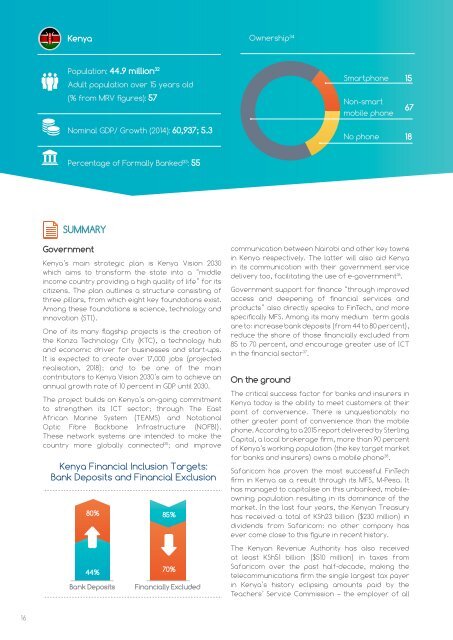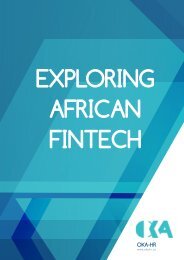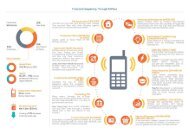FiA_2015
Create successful ePaper yourself
Turn your PDF publications into a flip-book with our unique Google optimized e-Paper software.
Kenya<br />
Ownership 34 Smartphone 15<br />
Population: 44.9 million 32<br />
Adult population over 15 years old<br />
(% from MRV figures): 57<br />
Non-smart<br />
mobile phone<br />
67<br />
Nominal GDP/ Growth (2014): 60,937; 5.3<br />
No phone 18<br />
Percentage of Formally Banked 33 : 55<br />
SUMMARY<br />
Government<br />
Kenya’s main strategic plan is Kenya Vision 2030<br />
which aims to transform the state into a “middle<br />
income country providing a high quality of life” for its<br />
citizens. The plan outlines a structure consisting of<br />
three pillars, from which eight key foundations exist.<br />
Among these foundations is science, technology and<br />
innovation (STI).<br />
One of its many flagship projects is the creation of<br />
the Konza Technology City (KTC), a technology hub<br />
and economic driver for businesses and start-ups.<br />
It is expected to create over 17,000 jobs (projected<br />
realisation, 2018); and to be one of the main<br />
contributors to Kenya Vision 2030’s aim to achieve an<br />
annual growth rate of 10 percent in GDP until 2030.<br />
The project builds on Kenya’s on-going commitment<br />
to strengthen its ICT sector; through The East<br />
African Marine System (TEAMS) and Notational<br />
Optic Fibre Backbone Infrastructure (NOFBI).<br />
These network systems are intended to make the<br />
country more globally connected 35 ; and improve<br />
Kenya Financial Inclusion Targets:<br />
Bank Deposits and Financial Exclusion<br />
80%<br />
44%<br />
Bank Deposits<br />
85%<br />
70%<br />
Financially Excluded<br />
communication between Nairobi and other key towns<br />
in Kenya respectively. The latter will also aid Kenya<br />
in its communication with their government service<br />
delivery too, facilitating the use of e-government 36 .<br />
Government support for finance “through improved<br />
access and deepening of financial services and<br />
products” also directly speaks to FinTech, and more<br />
specifically MFS. Among its many medium term goals<br />
are to: increase bank deposits (from 44 to 80 percent),<br />
reduce the share of those financially excluded from<br />
85 to 70 percent, and encourage greater use of ICT<br />
in the financial sector 37 .<br />
On the ground<br />
The critical success factor for banks and insurers in<br />
Kenya today is the ability to meet customers at their<br />
point of convenience. There is unquestionably no<br />
other greater point of convenience than the mobile<br />
phone. According to a <strong>2015</strong> report delivered by Sterling<br />
Capital, a local brokerage firm, more than 90 percent<br />
of Kenya’s working population (the key target market<br />
for banks and insurers) owns a mobile phone 38 .<br />
Safaricom has proven the most successful FinTech<br />
firm in Kenya as a result through its MFS, M-Pesa. It<br />
has managed to capitalise on this unbanked, mobileowning<br />
population resulting in its dominance of the<br />
market. In the last four years, the Kenyan Treasury<br />
has received a total of KSh23 billion ($230 million) in<br />
dividends from Safaricom: no other company has<br />
ever come close to this figure in recent history.<br />
The Kenyan Revenue Authority has also received<br />
at least KSh51 billion ($510 million) in taxes from<br />
Safaricom over the past half-decade, making the<br />
telecommunications firm the single largest tax payer<br />
in Kenya’s history eclipsing amounts paid by the<br />
Teachers’ Service Commission – the employer of all<br />
16





